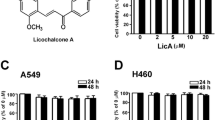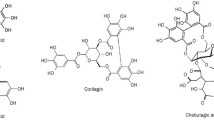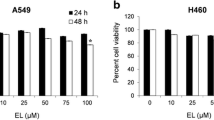Abstract
Cell migration is essential for invasive and metastatic phenotypes of cancer cells. Potential chemopreventive agents of cancer—sulindac sulfide, caffeic acid phenethyl ester (CAPE), curcumin, and (+)-catechin—have been reported to interfere with several types of intracellular signaling. In this study, we examined the effects of these agents on transforming growth factor-β(TGF-β)-induced motility and Akt phosphorylation in A549 cells. Judged by gold particle phagokinesis assay, sulindac sulfide, CAPE, and curcumin suppressed the motility of A549 cells promoted by TGF-β. LY294002, a specific inhibitor of phosphatidylinositol 3-kinase(PI3K)/Akt signaling, also suppressed TGF-β-induced motility and Akt phosphorylation. Sulindac sulfide and CAPE, but not curcumin, suppressed TGF-β-induced Akt phosphorylation. We conclude that sulindac sulfide and CAPE suppress the motility promoted by TGF-β in lung adenocarcinoma cells through the suppression of Akt. Our observations raise the possibility that these agents, except for (+)-catechin, can be applied not only as chemopreventive agents but also as anti-metastatic therapy.




Similar content being viewed by others
Abbreviations
- CAPE:
-
Caffeic acid phenethyl ester
- TGF-β:
-
Transforming growth factor-β
- FAK:
-
Focal adhesion kinase
- MMP-2:
-
Matrix metalloproteinase-2
References
Akhurst RJ (2002) TGF-β antagonists: why suppress a tumor suppressor? J Clin Invest 109:1533–1536
Akhurst RJ, Derynck R (2001) TGF-β signaling in cancer—a double-edged sword. Trends Cell Biol 11:S44–51
Albrecht-Buehler G (1977) The phagokinetic tracks of 3T3 cells. Cell 11:395–404
Alessi DR, Andjelkovic M, Caudwell B, Cron P, Morrice N, Cohen P, Hemmings BA (1996) Mechanism of activation of protein kinase B by insulin and IGF-1. Embo J 15:6541–6551
Arbiser JL, Klauber N, Rohan R, van Leeuwen R, Huang MT, Fisher C, Flynn E, Byers HR (1998) Curcumin is an in vivo inhibitor of angiogenesis. Mol Med 4:376–383
Arico S, Pattingre S, Bauvy C, Gane P, Barbat A, Codogno P, Ogier-Denis E (2002) Celecoxib induces apoptosis by inhibiting 3-phosphoinositide-dependent protein kinase-1 activity in the human colon cancer HT-29 cell line. J Biol Chem 277:27613–27621
Bakin AV, Tomlinson AK, Bhowmick NA, Moses HL, Arteaga CL (2000) Phosphatidylinositol 3-kinase function is required for transforming growth factor β-mediated epithelial to mesenchymal transition and cell migration. J Biol Chem 275:36803–36810
Bhowmick NA, Ghiassi M, Bakin A, Aakre M, Lundquist CA, Engel ME, Arteaga CL, Moses HL (2001) Transforming growth factor-β1 mediates epithelial to mesenchymal transdifferentiation through a RhoA-dependent mechanism. Mol Biol Cell 12:27–36
Cai T, Lei QY, Wang LY, Zha XL (2000) TGF-β1 modulated the expression of α5β1 integrin and integrin-mediated signaling in human hepatocarcinoma cells. Biochem Biophys Res Commun 274:519–525
Dunn SE, Torres JV, Oh JS, Cykert DM, Barrett JC (2001) Up-regulation of urokinase-type plasminogen activator by insulin-like growth factor-I depends upon phosphatidylinositol-3 kinase and mitogen-activated protein kinase kinase. Cancer Res 61:1367–1374
Ellenrieder V, Hendler SF, Ruhland C, Boeck W, Adler G, Gress TM (2001) TGF-β-induced invasiveness of pancreatic cancer cells is mediated by matrix metalloproteinase-2 and the urokinase plasminogen activator system. Int J Cancer 93:204–211
Fausto N (1991) Multifunctional roles for transforming growth factor-β1. Lab Invest 65:497–499
Giardiello FM, Hamilton SR, Krush AJ, Piantadosi S, Hylind LM, Celano P, Booker SV, Robinson CR, Offerhaus GJ (1993) Treatment of colonic and rectal adenomas with sulindac in familial adenomatous polyposis. N Engl J Med 328:1313–1316
Hanahan D, Weinberg RA (2000) The hallmarks of cancer. Cell 100:57–70
Hsu AL, Ching TT, Wang DS, Song X, Rangnekar VM, Chen CS (2000) The cyclooxygenase-2 inhibitor celecoxib induces apoptosis by blocking Akt activation in human prostate cancer cells independently of Bcl-2. J Biol Chem 275:11397–11403
Imai K, Suga K, Nakachi K (1997) Cancer-preventive effects of drinking green tea among a Japanese population. Prev Med 26:769–775
Johnson AN, Newfeld SJ (2002) The TGF- Family: signaling pathways, developmental roles, and tumor suppressor activities. Sci World J 2:892–925
Labayle D, Fischer D, Vielh P, Drouhin F, Pariente A, Bories C, Duhamel O, Trousset M, Attali P (1991) Sulindac causes regression of rectal polyps in familial adenomatous polyposis. Gastroenterology 101:635–639
Michaluart P, Masferrer JL, Carothers AM, Subbaramaiah K, Zweifel BS, Koboldt C, Mestre JR, Grunberger D, Sacks PG, Tanabe T, Dannenberg AJ (1999). Inhibitory effects of caffeic acid phenethyl ester on the activity and expression of cyclooxygenase-2 in human oral epithelial cells and in a rat model of inflammation. Cancer Res 59:2347–2352
Mooradian DL, McCarthy JB, Komanduri KV, Furcht LT (1992) Effects of transforming growth factor-β1 on human pulmonary adenocarcinoma cell adhesion, motility, and invasion in vitro. J Natl Cancer Inst 84:523–527
Morales-Ruiz M, Fulton D, Sowa G, Languino LR, Fujio Y, Walsh K, Sessa WC (2000) Vascular endothelial growth factor-stimulated actin reorganization and migration of endothelial cells is regulated via the serine/threonine kinase Akt. Circ Res 86:892–896
Muraoka RS, Dumont N, Ritter CA, Dugger TC, Brantley DM, Chen J, Easterly E, Roebuck LR, Ryan S, Gotwals PJ, Koteliansky V, Arteaga CL (2002) Blockade of TGF-β inhibits mammary tumor cell viability, migration, and metastases. J Clin Invest 109:1551–1559
Murata K, Kameyama M, Fukui F, Ohigashi H, Hiratsuka M, Sasaki Y, Kabuto T, Mukai M, Mammoto T, Akedo H, Ishikawa O, Imaoka S (1999) Phosphodiesterase type III inhibitor, cilostazol, inhibits colon cancer cell motility. Clin Exp Metastasis 17:525–530
Nakamura K, Yano H, Schaefer E, Sabe H (2001) Different modes and qualities of tyrosine phosphorylation of Fak and Pyk2 during epithelial-mesenchymal transdifferentiation and cell migration: analysis of specific phosphorylation events using site-directed antibodies. Oncogene 20:2626–2635
Nakanishi K, Sakamoto M, Yasuda J, Takamura M, Fujita N, Tsuruo T, Todo S, Hirohashi S (2002) Critical involvement of the phosphatidylinositol 3-kinase/Akt pathway in anchorage-independent growth and hematogeneous intrahepatic metastasis of liver cancer. Cancer Res 62:2971–2975
Nakashio A, Fujita N, Tsuruo T (2002) Topotecan inhibits VEGF- and bFGF-induced vascular endothelial cell migration via downregulation of the PI3K-Akt signaling pathway. Int J Cancer 98:36–41
Nicholson KM, Anderson NG (2002) The protein kinase B/Akt signalling pathway in human malignancy. Cell Signal 14:381–395
Nugent KP, Farmer KC, Spigelman AD, Williams CB, Phillips RK (1993) Randomized controlled trial of the effect of sulindac on duodenal and rectal polyposis and cell proliferation in patients with familial adenomatous polyposis. Br J Surg 80:1618–1619
Park BK, Zeng X, Glazer RI (2001) Akt induces extracellular matrix invasion and matrix metalloproteinase-2 activity in mouse mammary epithelial cells. Cancer Res 61:7647–7653
Parsons JT (2003) Focal adhesion kinase: the first ten years. J Cell Sci 116:1409–1416
Parsons JT, Martin KH, Slack JK, Taylor JM, Weed SA (2000) Focal adhesion kinase: a regulator of focal adhesion dynamics and cell movement. Oncogene 19:5606–5613
Platten M, Wick W, Wild-Bode C, Aulwurm S, Dichgans J, Weller M (2000) Transforming growth factors β1 (TGF-β1) and TGF-β2 promote glioma cell migration via Up-regulation of α5β3 integrin expression. Biochem Biophys Res Commun 268:607–611
Rajgolikar G, Chan KK, Wang HC (1998) Effects of a novel antitumor depsipeptide, FR901228, on human breast cancer cells. Breast Cancer Res Treat 51:29–38
Rice PL, Goldberg RJ, Ray EC, Driggers LJ, Ahnen DJ (2001) Inhibition of extracellular signal-regulated kinase 1/2 phosphorylation and induction of apoptosis by sulindac metabolites. Cancer Res 61:1541–1547
Roberts AB, Derynck R (2001) Meeting report: signaling schemes for TGF-β. Sci STKE 2001 PE43
Santibanez JF, Quintanilla M, Martinez J (2000) Genistein and curcumin block TGF-β1-induced u-PA expression and migratory and invasive phenotype in mouse epidermal keratinocytes. Nutr Cancer 37:49–54
Shao ZM, Shen ZZ, Liu CH, Sartippour MR, Go VL, Heber D, Nguyen M (2002) Curcumin exerts multiple suppressive effects on human breast carcinoma cells. Int J Cancer 98:234–240
Steinbach G, Lynch PM, Phillips RK, Wallace MH, Hawk E, Gordon GB, Wakabayashi N, Saunders B, Shen Y, Fujimura T, Su LK, Levin B (2000) The effect of celecoxib, a cyclooxygenase-2 inhibitor, in familial adenomatous polyposis. N Engl J Med 342:1946–1952
Tai YT, Podar K, Mitsiades N, Lin B, Mitsiades C, Gupta D, Akiyama M, Catley L, Hideshima T, Munshi NC, Treon SP, Anderson KC (2003) CD40 induces human multiple myeloma cell migration via phosphatidylinositol 3-kinase/Akt/NF-κB signaling. Blood 101:2762–2769
Weyant MJ, Carothers AM, Bertagnolli ME, Bertagnolli MM (2000) Colon cancer chemopreventive drugs modulate integrin-mediated signaling pathways. Clin Cancer Res 6:949–956
Whitehead RH, Joseph JL (1994) Derivation of conditionally immortalized cell lines containing the Min mutation from the normal colonic mucosa and other tissues of an “Immortomouse”/Min hybrid. Epithelial Cell Biol 3:119–125
Wright JA, Huang A (1996) Growth factors in mechanisms of malignancy: roles for TGF-β and FGF. Histol Histopathol 11:521–536
Yamamoto Y, Yin MJ, Lin KM, Gaynor RB (1999) Sulindac inhibits activation of the NF-κB pathway. J Biol Chem 274:27307–27314
Yamazaki R, Kusunoki N, Matsuzaki T, Hashimoto S, Kawai S (2002) Selective cyclooxygenase-2 inhibitors show a differential ability to inhibit proliferation and induce apoptosis of colon adenocarcinoma cells. FEBS Lett 531:278–284
Yang YA, Dukhanina O, Tang B, Mamura M, Letterio JJ, MacGregor J, Patel SC, Khozin S, Liu ZY, Green J, Anver MR, Merlino G, Wakefield LM (2002) Lifetime exposure to a soluble TGF-β antagonist protects mice against metastasis without adverse side effects. J Clin Invest 109:1607–1615
Zhu J, Song X, Lin HP, Young DC, Yan S, Marquez VE, Chen CS (2002) Using cyclooxygenase-2 inhibitors as molecular platforms to develop a new class of apoptosis-inducing agents. J Natl Cancer Inst 94:1745–1757
Author information
Authors and Affiliations
Corresponding author
Rights and permissions
About this article
Cite this article
Shigeoka, Y., Igishi, T., Matsumoto, S. et al. Sulindac sulfide and caffeic acid phenethyl ester suppress the motility of lung adenocarcinoma cells promoted by transforming growth factor-β through Akt inhibition. J Cancer Res Clin Oncol 130, 146–152 (2004). https://doi.org/10.1007/s00432-003-0520-0
Received:
Accepted:
Published:
Issue Date:
DOI: https://doi.org/10.1007/s00432-003-0520-0




